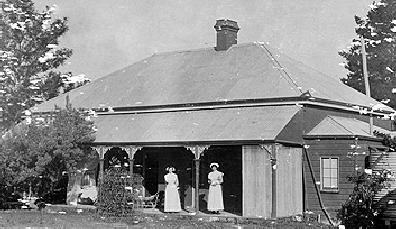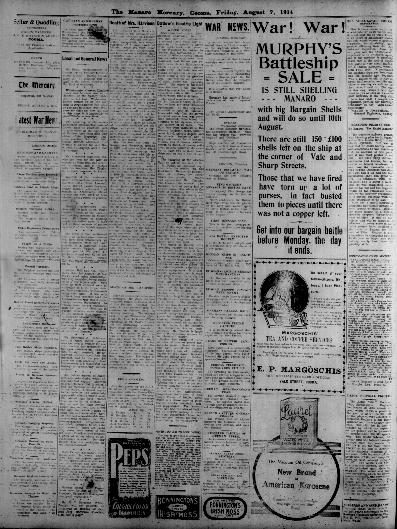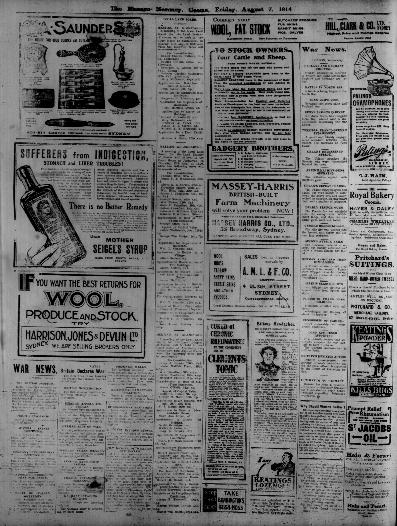Topic: GW - August 1914

Due to the time zone differences, the declaration of war by Britain against Germany, while officially recorded as 4 August 1914, in terms of Australia, did not happen until Wednesday, 5 August 1915. For the The Monaro Mercury, this did not happen until the end of the week, on Friday, 7 August 1914.
Apart from being a major regional agricultural centre, the Cooma region supported minor military training facilities. The Militia formations throughout the region included: Cooma, 11th Australian Light Horse Regiment, Machine Gun Section and "A" Squadron (part); Cooma Rifle Club; Adaminaby Rifle Club; Bombala Rifle Club; Nimitybelle Rifle Club; Berridale Rifle Club; and, Dalgety Rifle Club
Cooma was a regional centre which boasted of a weekly newspaper published every Friday called The Monaro Mercury incorporating the Cooma and Bombala Advertiser. The Monaro Mercury was priced at 3d [3 pence or in 2008 AUD, $5] per edition. The newspaper was circulated around the Cooma region including the locations and towns of Cooma, Bombala, Nimmitabel, Berridale, Dalgety, Maffra, Coonerang, Adaminaby, Kiandra, and Bredbo.
The area around the Cooma region is composed mainly of undulating pastures puctuated by two alpine regions with snow peaked mountains in the winter. The region presents a diverse landscape of agriculture mixed with wilderness. Cooma was the primary city in the region offering key services to sheep grazing activities. The following two pages are indicative of the life experienced in the Cooma region when the Great War was declared.
War is Declared
This page explores the way The Monaro Mercury dealt with the news.
[Click on page for larger version - 938kb]
War! War!
Advertisers were quick to trivialise the ghastly business of war in order to turn a quick profit. It was an Australian wide phenomenon that lasted until the casualty reports began to filter in from Gallipoli. Until then, it was the Great Game and Great Adventure.
Murphy's on the corner of Vale and Sharp Streets, one of the prime locations in Cooma, used the "War!" motif to sell his goods.
Always ensure there is at least one cemetery in an electorate
The old Sussex Street Trades Hall saw that a good electorate should contain at least one, if not more cemeteries, seems to have been the target of Mr Palmer Sutton of Fontenoy. Suspicious that the Labor Party was utilising the cemetery vote to win the seat against the Liberal Party candidate, Sutton went through the electoral roll of his area and discovered many anomalies. So angered that the election might be stolen, he penned his letter to The Monaro Mercury with the intent to alert the public of his discovery. Below is his letter:
Mr Palmer Sutton
Fontenoy near Adaminaby
2 August 1914:
Allow me to send electoral list in which I find no mention of my name or my wife's. I cause inquiry to be made by the Adaminaby postmaster about a month since who stated that both names were on the list of electors. I find in said list that several names are omitted, also a few who have died which I mark in black ink, and some who have left this part a considerable time marked in coloured ink. The above mentioned irregularities are chiefly injurious to the Liberal interest. There are probably many more errors in the list sent. I only attend to those I know of as my circle of acquaintances is small. Our fair friends here are anxious in the Liberal interest.
The cemetery vote was always an important element in the New South Wales electoral system. With many dead people enrolled, party hacks would then vote in the name of the deceased. This common practice lead to the second adage: "Vote early and vote often." Usually attributed to Mayor William Hale Thompson of Chicargo, it was well and truly embedded in the political process of the time. It took many decades for these corrupt practices to be excised from the electoral system ensuring a fair result.
The Cooma Rifle Club
The first round of shooting towards the Lovegrove Trophy and the NRA [National Rifle Association] Medal took place on Wednesday, 5 August 1914. The competition involved ten shots from 300 yards [274m]. A. Fallick and W Kaufline won the cash prizes. The other shooters who scored well included F Gunning, TW McRae, JA Goodwin and A McDonald.
The rifle clubs were an important source of trained recruits for the AIF. Many of the Light Horsemen who volunteered for overseas service with the AIF were members of the local rifle club.
Light Horsemen from the Cooma RegionThe following list is of the known men who enlisted in the Australian Light Horse during the Great War and saw overseas service. The enlistments are in regimental unit in which he enlisted, although not necessarily served. The fate of the man is the last record.
- 232 Trooper Joseph Dermod Little, 1st Field Ambulance, returned to Australia.
- 195 Trooper Charles Vivian Owers, 1st Field Ambulance, returned to Australia.
- 21431 Trooper Pierre Marie Antoine Speet, 1st Field Squadron Engineers - January, 1918, Reinforcements, returned to Australia.
- 288 Trooper Athol Robert Ashworth, 1st Light Horse Regiment, B Squadron, returned to Australia.
- 1386 Trooper Francis Harold Burgess, 1st Light Horse Regiment, 11th Reinforcement, returned to Australia.
- 3413 Trooper Richard John Collins, 1st Light Horse Regiment, 29th Reinforcement, returned to Australia.
- 2465 Trooper Laurence John Delaney, 1st Light Horse Regiment, 17th Reinforcement, returned to Australia.
- 3774 Trooper Edward George Dewdney, 1st Light Horse Regiment, 35th Reinforcement, returned to Australia.
- 330 Trooper Monaghan Raymond Hayes, 1st Light Horse Regiment, B Squadron, Killed in Action at Gallipoli, 31 July 1915.
- 1443 Trooper Leslie David Hurley, 1st Light Horse Regiment, 11th Reinforcement, returned to Australia.
- 1890 Trooper Eric James Kelly, 1st Light Horse Regiment, 13th Reinforcement, returned to Australia.
- 272 Trooper George Clifton Mcgregor, 1st Light Horse Regiment, B Squadron, returned to Australia.
- 1102 Trooper Hugh Alfred Lawrence Mugridge, 1st Light Horse Regiment, 7th Reinforcement, returned to Australia.
- 322 Trooper Robert Leslie Paton, 1st Light Horse Regiment, B Squadron, returned to Australia.
- 366 Trooper Henry Francis Smith, 1st Light Horse Regiment, B Squadron, returned to Australia.
- 674 Trooper Artemus Stendley Alexander, 2nd Light Horse Brigade, Headquarters, returned to Australia.
- 2107 Trooper James Daniel Adams, 6th Light Horse Regiment, 14th Reinforcement, Killed in Action, Armentieres, France, 16 July 1916.
- 1862 Trooper John James Constance, 6th Light Horse Regiment, 13th Reinforcement, returned to Australia.
- 1866 Trooper Percy Thomas Constance, 6th Light Horse Regiment, 13th Reinforcement, returned to Australia.
- Second Lieutenant Reginald Charles David Garnock, 6th Light Horse Regiment, 2nd Reinforcement, returned to Australia.
- 2178 Trooper Harold Henry Gibbs, 6th Light Horse Regiment, 15th Reinforcement, returned to Australia.
- 370 Trooper Charles Reginald Bede Gill, 6th Light Horse Regiment, C Squadron, returned to Australia.
- 978 Trooper Leslie James Gurney, 6th Light Horse Regiment, 5th Reinforcement, returned to Australia.
- 2104 Trooper Charles Stanley Jamieson, 6th Light Horse Regiment, 14th Reinforcement, returned to Australia.
- 2103 Trooper David William Jamieson, 6th Light Horse Regiment, 14th Reinforcement, returned to Australia.
- 3488 Trooper Merion Charles Moriarty, 6th Light Horse Regiment, 30th Reinforcement, returned to Australia.
- 3138 Trooper Claude Mulhearn, 6th Light Horse Regiment, 24th Reinforcement, returned to Australia.
- Major Frederick Dudley Weedon Oatley, 6th Light Horse Regiment, 19th Reinforcement, returned to Australia.
- 1646 Trooper William Francis O'Donnell, 6th Light Horse Regiment, 12th Reinforcement, Killed in Action, Ypres, Belgium, 27 October 1917.
- 1106 Trooper Thomas William Plackett, 6th Light Horse Regiment, 7th Reinforcement, returned to Australia.
- 3540 Trooper Percy Norman Ryan, 6th Light Horse Regiment, 31st Reinforcement, returned to Australia.
- 2106 Trooper Farquher Henry Suthern, 6th Light Horse Regiment, 14th Reinforcement, returned to Australia.
- 2087 Trooper Howard Suthern, 6th Light Horse Regiment, 14th Reinforcement, returned to Australia.
- 2090 Trooper Douglas Lewis Thomas, 6th Light Horse Regiment, 14th Reinforcement, returned to Australia.
- 1524 Trooper Ernest James Toms, 6th Light Horse Regiment, 11th Reinforcement, returned to Australia.
- 2312 Trooper Francis Charles Bonny, 7th Light Horse Regiment, 16th Reinforcement, returned to Australia.
- 2157 Trooper Terry Patrick Bray, 7th Light Horse Regiment, 15th Reinforcement, returned to Australia.
- 2311 Trooper Henry Broadhead, 7th Light Horse Regiment, 16th Reinforcement, returned to Australia.
- 2636 Trooper Reginald James Brown, 7th Light Horse Regiment, 18th Reinforcement, returned to Australia.
- 929 Trooper Conyers Clifford, 7th Light Horse Regiment, 5th Reinforcement, Killed in Action at Gallipoli, 5 August 1915.
- 461 Trooper Albert James Filtness, 7th Light Horse Regiment, C Squadron, returned to Australia.
- 2647 Trooper Thomas James Gearin, 7th Light Horse Regiment, 18th Reinforcement, returned to Australia.
- 2663 Trooper Thomas William Hayes, 7th Light Horse Regiment, 18th Reinforcement, returned to Australia.
- 2125 Trooper Robert Albert Jones, 7th Light Horse Regiment, 14th Reinforcement, returned to Australia.
- 2833 Trooper Robert Matthews, 7th Light Horse Regiment, 19th Reinforcement, returned to Australia.
- 1671 Trooper William Henry Mcdonald, 7th Light Horse Regiment, 12th Reinforcement, returned to Australia.
- 3558 Trooper Patrick Cecil Mulhearn, 7th Light Horse Regiment, 31st Reinforcement, returned to Australia.
- 2409 Trooper Harrie Linden Murphy, 7th Light Horse Regiment, 16th Reinforcement, Killed in Action in Palestine, 30 August 1918.
- 1409 Trooper Alfred Joseph Rolfe, 7th Light Horse Regiment, 11th Reinforcement, returned to Australia.
- 1410 Trooper Arthur Lawrence Rolfe, 7th Light Horse Regiment, 11th Reinforcement, returned to Australia.
- 2277 Trooper Herbert Smart, 7th Light Horse Regiment, 15th Reinforcement, returned to Australia.
- 1771 Trooper Arthur Ephrone Staples, 7th Light Horse Regiment, 12th Reinforcement, returned to Australia.
- 352 Trooper Stewart Stone, 11th Light Horse Regiment, B Squadron, returned to Australia.
- 1373 Trooper Thomas Percy Barber, 12th Light Horse Regiment, 7th Reinforcement, returned to Australia.
- Captain Leslie Cowlishaw, 12th Light Horse Regiment, Headquarters, returned to Australia.
- 470 Trooper Maurice Edward Dawson, 12th Light Horse Regiment, C Squadron, returned to Australia.
- 142 Trooper James Arthur Gilbert, 12th Light Horse Regiment, A Squadron, and also 11th Reinforcement, returned to Australia.
- 1552 Trooper John Angus Muir, 12th Light Horse Regiment, 6th Reinforcement, returned to Australia.
- Lieutenant George Richard Irving, Australian Remount Unit 2, Squadron 6, returned to Australia.
- 1691 Trooper Charles Henry Stiles, Australian Remount Unit 2, Squadron 6, returned to Australia.
- 1141 Trooper Francis George Townsend, Australian Remount Unit 1, Squadron 4, returned to Australia.
- 17103 Trooper Arthur Lachlan Cochran, Australian Wireless Squadron 1, Reinforcement 7, returned to Australia.
- 1657 Trooper Victor Edward Brown, Camel Corps, November 1916 Reinforcements, returned to Australia.
- 1693 Trooper Harold Ronald Mcdonald, Camel Corps, November 1916 Reinforcements, returned to Australia.
- 3348 Trooper Percy Ernest O'connor, Camel Corps, May 1917 Reinforcements, returned to Australia.
- 3308 Trooper Arthur Sylvester Phillips, Camel Corps, May 1917 Reinforcements, returned to Australia.
- 1698 Trooper John Ballantine Simpson Robbie, Camel Corps November 1916 Reinforcements, returned to Australia.
- 1792 Trooper Boyd John Thurbon, Camel Corps November 1916 Reinforcements, returned to Australia.
- 4483 Trooper Arthur Duncan, General Service Reinforcements, Light Horse, February 1918 Reinforcements, returned to Australia.
Cooma Activities, 7 August 1914
While the war announcement was a significant story, the life of Cooma did not halt but just kept going on, as it did for the duration of the war. This page details quite clearly some of the life that occurred within the south Cooma region.
[Click on page for larger version - 895kb]
Adaminaby Lands Board Meeting
There might have been a war on but the day to day details of life were maintained. For the projected meeting of the Adaminaby Lands Board at the Court House on Wednesday, 12 August 1914 at 11am, items regarding the community structure were placed on notice for public discussion.
To deal with funding various community projects, assessment of properties for rating formed the major part of the proceedings. At this meeting they were examining the ratings for Percy A Brooks with his 2,200 acres [890.34 ha], Louisa Matilda Pryee and her 140.25 acres [56.76 ha], William Hamilton's 300 acres [121.41 ha], David Henderson and his 150 acres [60.70 ha] and the 67.5 acres [27.3 ha] belonging to Margaret Creaser. In addition, new land needed appraisal of rental or cleared land value. The noticeable item is the role women played as land holders and so as rate payers.
Apart from rating issues, there was an application by Mary Ann Green to erect a "Give and Take" fence. Robert M Stuart wanted to enclose the roads through his property while Joseph Heywood want to put rabbit proof fencing across the road that traversed his property.
The concept of a the "Give and Take" fence is a curious one which was made possible under the Closer Settlement Act 1904 where the local topography prevented the boundary line being fenced exactly between large country properties. Hence the concept of "Give and Take" - "I'll give you some of my land and I will take some of yours when the fence line is placed in a convenient topographical location." Rugged cliffs and such items made exact boundary fences difficult and under these circumstances, provided that it was considered by the land's board, was a satisfactory arrangement for all parties.
The enclosure of a road was also an important item for a farmer. The open road was often a source of major disagreement and complaint between neighbours. This was most especially so when stock was being driven to market. Other times occurred when oxen or horse drawn wagons moved along the track. The animals were more than happy to trample over another person's property to access water or fodder or both. this was especially true if the property was bisected by a busy road.
The rabbit proof fencing was indicative of the spread of rabbits in the area and the damage they were doing to the soil and vegetation. The employment of rabbit proof fences was a short term answer to a difficult question. It gave the farmer a few years respite from the property being over run by rabbits, an inevitable outcome regardless of the fence.
The Cooma District Hospital

Hospital Board
R Craig (President)
George Kaufline (Vice President)
BL Lovegrove (Vice President)
WH Gurney (Hon Treasurer)
J Ferari
H Gunning
SM Osborne
WJ Osbmond
EH Litchfield
H F Faulkner
WH Thomson
EH Quodling
JA Norris
JC Ryrie
OK Silk
AE Darling
DJ O'Rourke
CJ Walmsley (Treasurer)
WK Bannister (Auditor)
HH Solomon (Auditor)
Dr Harvison (Medical Officer)
Dr L Cowlishaw (Medical Officer)
T Faulkner (Medical Officer)
Dr Finley (Medical Officer)
Miss G Phillips (Matron)
HVS Wells (Dental Surgeon)
CF Moses (Dental Surgeon)
A few names stand out. The first is BL Lovegrove, after whom the Lovegrove Cup was named. [See Rifle Club above.] Dr L Cowlishaw served with the AIF as a Medical Officer. JC Ryrie came from the well known Ryrie family who originally settled in the Michaelago area.
The history revealed by a newspaper
A newspaper is a historical snapshot of a particular area on the day the newspaper was published. They contain a wealth of information which can be extracted and used according to the individual taste. The above extracts give an example of the depth of information contained within a simple rural newspaper. Every story contains many more stories, each layered upon each other like onion peels. As one peels away one skin, more appear to reveal a vibrant community brimming with history.
Do you want to take part in uncovering and writing Australian history?
If this entry or other entries inspires you to produce further insights, please feel free to post a response and it may become an acknowledged part of the article.
Further Reading:
Complete list of Newspaper References for 5 August 1914
Citation: The Monaro Mercury - War Declared





